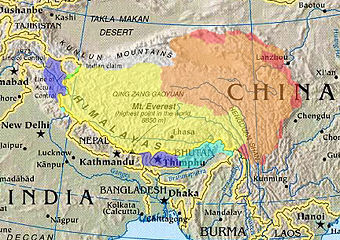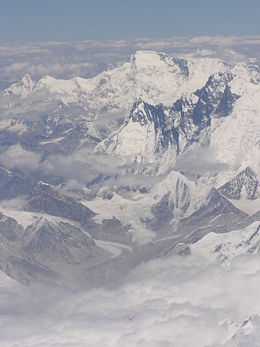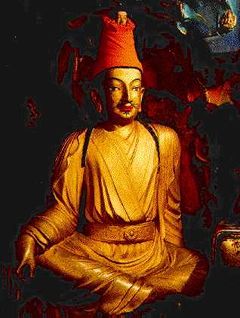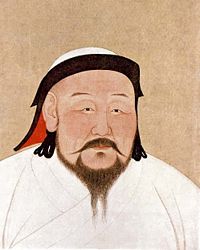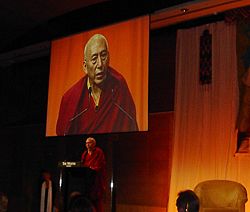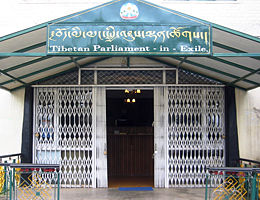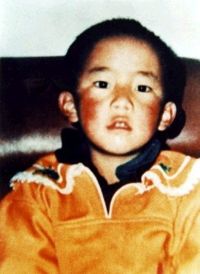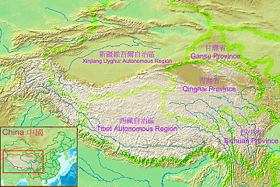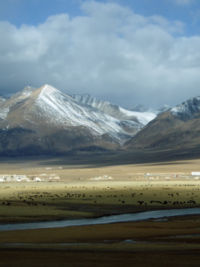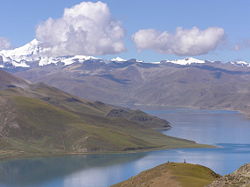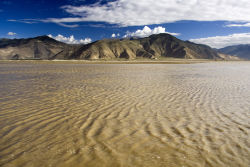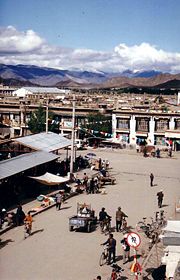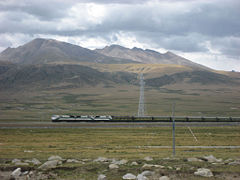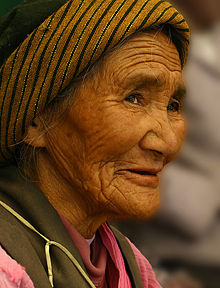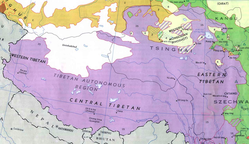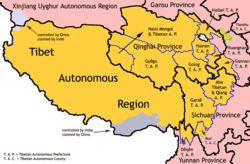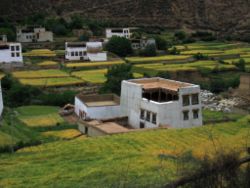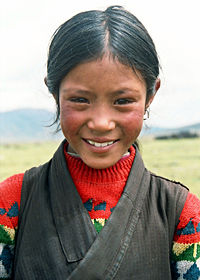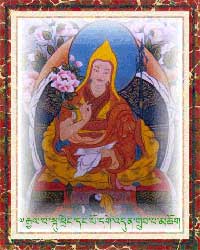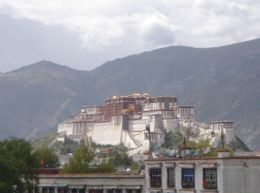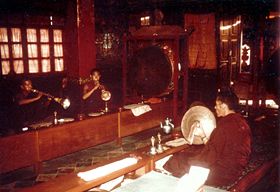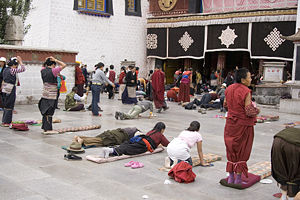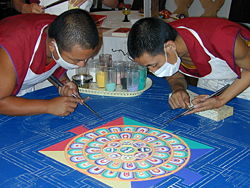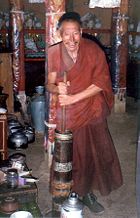Tibet
2008/9 Schools Wikipedia Selection. Related subjects: Asia; Asian Countries
| Tibet Autonomous Region within the People's Republic of China | |||||||||
| Historic Tibet as claimed by Tibetan exile groups | |||||||||
| Tibetan areas as designated by the People's Republic of China | |||||||||
| Chinese-controlled areas claimed by India as part of Aksai Chin | |||||||||
| Indian-controlled areas claimed by China as part of Tibet | |||||||||
| Other areas historically within Tibetan cultural sphere | |||||||||
Tibet ( Tibetan: བོད་; Wylie: bod) is a plateau region in Central Asia and the home to the indigenous Tibetan people. With an average elevation of 4,900 metres (16,000 ft), it is the highest region on Earth and is commonly referred to as the "Roof of the World." Geographically, UNESCO and Encyclopædia Britannica consider Tibet to be part of Central Asia, while several academic organizations consider it part of South Asia. Since what constitutes Tibet is a matter of much debate (see map, right) neither its size nor population are simple matters of fact.
Tibet was once an independent kingdom but today is part of the People's Republic of China (PRC) with a small part, depending on definitions, controlled by India. The Republic of China (commonly known as Taiwan) also lays a claim to Tibet as part of its exclusive mandate which includes a claim to all the territories currently governed by the PRC. Currently, the PRC government and the Government of Tibet in Exile still disagree over when Tibet became a part of China, and whether the incorporation into China of Tibet is legitimate according to international law.
A unifed Tibet first came into being under Songtsän Gampo in the seventh century. From the early 1600s until the 1959 uprising, the Dalai Lamas ( Tibetan Buddhist spiritual leaders) were, at least nominally, heads of a centralised Tibetan administration, with political power to administer religious and administrative authority over large parts of Tibet from the traditional capital Lhasa. They are believed to be the emanations of Avalokiteśvara (or "Chenrezig" [spyan ras gzigs] in Tibetan), the bodhisattva of compassion.
Definitions of Tibet
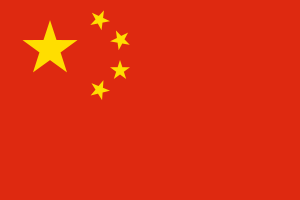
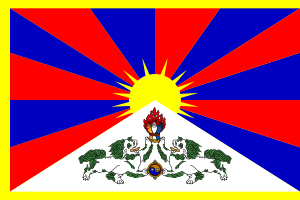
When the PRC government and some Tibetologists refer to Tibet, it means the areas covering Ü-Tsang and Western Kham, which became present-day the Tibet Autonomous Region, a provincial-level entity of the People's Republic. This definition, however, excludes the former domains of the Dalai Lamas in Amdo and eastern Kham which are part of Qinghai, Gansu, Yunnan, and Sichuan.
When the Government of Tibet in Exile and the Tibetan refugee community abroad refer to Tibet, they mean the areas consisting of the traditional provinces of Amdo, Kham, and Ü-Tsang.
The difference in definition is a major source of dispute. The distribution of Amdo and eastern Kham into surrounding provinces was initiated by the Yongzheng Emperor during the 18th century and has been continuously maintained by successive Chinese governments.
Tibetologists further comments on Amdo and Kham's status:
- "When the Dalai Lama speaks of Tibet, he speaks for an area more than three times the size of the TAR in which Tibetans live (Kham and Amdo). The historical reality is that the Dalai Lamas have not ruled these outer areas since the mid-eighteenth century, and during the Simla Conference of 1913, the thirteenth Dalai Lama was even willing to sign away rights to them"
- "[Dalai Lama] claimed all of Kham and Amdo in the Simla Convention of 1913-14 – most of these areas in fact were not a part of its polity for the two centuries preceding the rise to power of the Communists in China in 1949....The term ‘Tibet’ refers to the political state ruled by the Dalai Lamas; it does not refer to the ethnic border areas such as Amdo and Kham which were not part of that state in modern times, let alone to Ladakh or Northern Nepal. Until recently, this convention was, as far as I can discern, universally accepted in the scholarly literature"
- "The goal of a Greater Tibet was not at all politically realistic. Tibet had not ruled most of these areas for a century or more"
Name
In English
The English word Tibet, like the word for Tibet in most European languages, is derived from the Arabic word Tubbat. This word is derived via Persian from the Turkic word Töbäd (plural of Töbän), meaning "the heights". In Medieval Chinese, 吐蕃 (pronounced tufan), is derived from the same Turkic word. 吐蕃 was pronounced /t'o-bwǝn/ in Medieval times.
The exact derivation of the name is, however, still unclear. Some scholars believe that the named derived from that of a people who lived in the region of northeastern Tibet and were referred to as 'Tübüt'. This was the form adapted by the Muslim writers who rendered it Tübbett, Tibbat, etc., from as early as the 9th century, and it then entered European languages from the reports of the medieval European accounts of Piano-Carpini, Rubruck, Marco Polo and the Capuchin monk Francesco della Penna.
PRC scholars favour the theory that "Tibet" is derived from tǔbō.
In Tibetan
Tibetans call their homeland Bod (བོད་), pronounced [pʰøʔ] in Lhasa dialect. It is first attested in the geography of Ptolemy as βαται (batai) (Beckwith, C. U. of Indiana Diss. 1977).
In Chinese
The PRC's Chinese name for Tibet, 西藏 (Xīzàng), is a phonetic transliteration derived from the region called Tsang (western Ü-Tsang). The Chinese name originated during the Qing Dynasty of China, ca. 1700. It can be broken down into “xī” 西 (literally “west”), and “zàng” 藏 (from Ü-Tsang, but also literally “Buddhist scripture,” or “storage” or possibly "treasure"). The pre-1700s historic Chinese term for Tibet was 吐蕃. In modern Standard Mandarin, the first character is pronounced "tǔ". The second character is normally pronounced "fān"; in the context of references to Tibet, most authorities say that it should be pronounced "bō", while some authorities state that it should be pronounced as "fān". A reconstructed Medieval Chinese pronunciation would be /t'obwǝn/, which comes from the Turkic word for “heights” which is also the origin of the English term “Tibet”. When expressing themselves in Chinese, many exiled Tibetans, including the Dalai Lama's government in Daramsala, now use the term 吐博 Tǔbó.
The PRC government equates Tibet with the Tibet Autonomous Region (TAR). As such, the name “Xīzàng” is equated with the TAR. Some English-speakers reserve “Xīzàng”, the Chinese word transliterated into English, for the TAR, to keep the concept distinct from that of historic Tibet.The character 藏 (zàng) has been used in transcriptions referring to Tsang as early as the Yuan Dynasty, if not earlier, though the modern term "Xizang" (western Tsang) was devised in the 18th century. The Chinese character 藏 (Zàng) has also been generalized to refer to all of Tibet, including other concepts related to Tibet such as the Tibetan language (藏文, Zàngwén) and the Tibetan people (藏族, Zàngzú).
Language
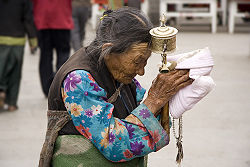
The Tibetan language is generally classified as a Tibeto-Burman language of the Sino-Tibetan language family although the boundaries between 'Tibetan' and certain other Himalayan languages can be unclear. According to Matthew Kapstein:
From the perspective of historical linguistics, Tibetan most closely resembles Burmese among the major languages of Asia. Grouping these two together with other apparently related languages spoken in the Himalayan lands, as well as in the highlands of Southeast Asia and the Sino-Tibetan frontier regions, linguists have generally concluded that there exists a Tibeto-Burman family of languages.... More controversial is the theory that the Tibeto-Burman family is itself part of a larger language family, called Sino-Tibetan, and that through it Tibetan and Burmese are distant cousins of Chinese.
The language is spoken in numerous regional dialects which, although sometimes mutually intelligible, generally cannot be understood by the speakers of the different oral forms of Tibetan. It is employed throughout the Tibetan plateau and Bhutan and is also spoken in parts of Nepal and northern India, such as Sikkim. In general, the dialects of central Tibet (including Lhasa), Kham, Amdo and some smaller nearby areas are considered Tibetan dialects. Other forms, particularly Dzongkha, Sikkimese, Sherpa, and Ladakhi, are considered by their speakers, largely for political reasons, to be separate languages. However, if the latter group of Tibetan-type languages are included in the calculation then 'greater Tibetan' is spoken by approximately 6 million people across the Tibetan Plateau. Tibetan is also spoken by approximately 150,000 exile speakers who have fled from modern-day Tibet to India and other countries.
Although spoken Tibetan varies according to the region, the written language, based on Classical Tibetan, is consistent throughout. This is probably due to the long-standing influence of the Tibetan empire, whose rule embraced (and extended at times far beyond) the present Tibetan linguistic area, which runs from northern Pakistan in the west to Yunnan and Sichuan in in the east, and from north of the Kokonor lake (Qinghai) south as far as Bhutan. The Tibetan language has its own script that it shares with Ladakhi and Dzongkha, which is derived from the ancient Indian Brahmi script.
History
The general history of Tibet begins with the rule of Songtsän Gampo (604–50 CE) who united parts of the Yarlung River Valley and ruled Tibet as a kingdom. He also brought in many reforms and Tibetan power spread rapidly creating a large and powerful empire. In 640 he married Princess Wencheng, the niece of the powerful Chinese emperor Emperor Taizong of Tang China.
Under the next few kings who followed Songsten Gampo, Buddhism became established as the state religion and Tibetan power increased even further over large areas of Central Asia while major inroads were made into Chinese territory, even reaching the Chinese capital Chang'an (modern Xian) in late 763. However, Tibetan troops occupied Chang'an for only fifteen days.
Nanzhao (in Yunnan and neighbouring regions) remained under Tibetan control from 750 to 794, when they turned on their Tibetan overlords and helped the Chinese inflict a serious defeat on the Tibetans.
The Tibetans were allied with the Arabs and eastern Turks. In 747, the hold of Tibet was loosened by the campaign of general Gao Xianzhi, who tried to re-open the direct communications between Central Asia and Kashmir. By 750 the Tibetans had lost almost all of their central Asian possessions to the Chinese. However, after Gao Xianzhi's defeat by the Arabs and Qarluqs at the Battle of Talas river (751), Chinese influence decreased rapidly and Tibetan influence resumed. In 821/822 CE Tibet and China signed a remarkable peace treaty. A bilingual account of this treaty including details of the borders between the two countries are inscribed on a stone pillar which stands outside the Jokhang temple in Lhasa. Tibet continued as a Central Asian empire until the mid-9th century.
Tibet and the Mongols
At the end of the 1230s, the Mongols turned their attention to Tibet. At that time, Mongol armies had already conquered Northern China, much of Central Asia, and as far as Russia and modern Ukraine. The Tibetan nobility, however, was fragmented and mainly occupied with internal strife. Göden, a brother of Güyük, entered the country in 1240. A second invasion led to the submission almost all Tibetan states. In 1244, Göden summoned the Sakya Pandita to his court, and in 1247 appointed Sakya the Mongolian viceroy for Central Tibet, though the eastern provinces of Kham and Amdo remained "under direct Mongol rule". When Kublai Khan founded Yuan Dynasty in 1271, Tibet became a part of the Yuan Dynasty.
Between 1346 and 1354, towards the end of the Yuan Dynasty, the House of Pagmodru toppled the Sakya. The following 80 years were a period of relative stability. They also saw the birth of the Gelugpa school (also known as Yellow Hats) by the disciples of Tsongkhapa Lobsang Dragpa, and the founding of the important Ganden, Drepung, and Sera monasteries near Lhasa. After the 1430s, the country entered another period of internal power struggles.
In 1578, Altan Khan of the Tümed Mongols invited Sonam Gyatso, a high lama of the Gelugpa school. They met near Khökh Nuur, where Altan Khan first referred to Sönam Gyatso as the Dalai Lama; Dalai being the Mongolian translation of the Tibetan name Gyatso, or "Ocean".
Events leading to Qing dominion of Tibet
In the 1630s, Tibet became entangled in the power struggles between the rising Manchu and various Mongol and Oirad factions. Ligden Khan of the Mongolian Chakhar tribe, retreating from the Manchu forces, set out to destroy the Yellow Hat Gelug school in Tibet but died on the way near Kokonor, in 1634. His vassal Tsogt Taij continued the fight but was defeated and killed by Güshi Khan of the Khoshud in 1637, who, in turn, became the overlord over Tibet, and acted as a "Protector of the Yellow Church". Güshi helped the Fifth Dalai Lama to establish himself as the highest spiritual and political authority in Tibet and destroyed any potential rivals.
In 1705, Lobzang Khan of the Khoshud used the 6th Dalai Lama's refusal of the role of a monk (although the encumbant did not reject his political role as Dalai Lama) as an excuse to take control of Tibet. The regent was murdered, and the Dalai Lama sent to Beijing. He died on the way, also near Kokonor, ostensibly from illness. Lobzang Khan appointed a new Dalai Lama, who, however, was not accepted by the Gelugpa school.
A rival reincarnation was found in the region of Kokonor. The Dzungars invaded Tibet in 1717, deposed and killed a pretender to the position of Dalai Lama (who had been promoted by Lhabzang), which met with widespread approval. However, the Dzungars soon began to loot the holy places of Lhasa which brought a swift response from Emperor Kangxi in 1718, but his military expedition was annihilated by the Dzungars not far from Lhasa.
Emperor Kangxi finally expelled the Dzungars from Tibet in 1720 and the troops were hailed as liberators. They brought Kelzang Gyatso with them from Kumbum to Lhasa and he was installed as the Seventh Dalai Lama in 1721, though they did not make Tibet a province, allowed it to maintain its own officials and legal and administrative systems, and levied no taxes. However, the Manchu Qing put Amdo under their control in 1724, and incorporated eastern Kham into neighbouring Chinese provinces in 1728. The Qing government sent a resident commissioner, namely Amban, to Lhasa. In 1751, Emperor Qianlong installed the Dalai Lama as both the spiritual leader and political leader of Tibet leading the government, namely Kashag.
Tibet under Qing
While the ancient relations between Tibet and China are complicated, there can be no question regarding the subordination of Tibet to Manchu-ruled China following first decades of the 18th century. In 1788, Gurkha forces sent by Bahadur Shah, the Regent of Nepal, invaded Tibet, occupying a number of frontier districts. The young Panchen Lama fled to Lhasa and Qing Emperor Qianlong sent troops to Lhasa, upon which the Nepalese withdrew agreeing to pay a large annual sum. In 1791 the Nepalese Gurkhas invaded Tibet a second time, seizing Shigatse and destroyed, plundered, and desecrated the great Tashilhunpo Monastery. The Panchen Lama was forced to flee to Lhasa once again. Emperor Qianlong then sent an army of 17,000 men to Tibet. In 1793, with the assistance of Tibetan troops, they managed to drive the Nepalese troops to within about 30 km of Kathmandu.
The first Europeans to arrive in Tibet were Portuguese missionaries in 1624 and were welcomed by the Tibetans who allowed them to build a church. The 18th century brought more Jesuits and Capuchins from Europe who gradually met opposition from Tibetan lamas who finally expelled them from Tibet in 1745. However, at the time not all Europeans were banned from the country — in 1774 a Scottish nobleman, George Bogle, came to Shigatse to investigate trade for the British East India Company, introducing the first potatoes into Tibet.
However, by the 19th century the situation of foreigners in Tibet grew more tenuous. The British Empire was encroaching from northern India into the Himalayas and Afghanistan and the Russian Empire of the tsars was expanding south into Central Asia and each power became suspicious of intent in Tibet. Sándor Kőrösi Csoma, the Hungarian scientist spent 20 years in British India (4 years in Ladakh) trying to visit Tibet. He created the first Tibetan-English dictionary.
By the 1850s Tibet had banned all foreigners from Tibet and shut its borders to all outsiders.
In 1865 Great Britain began secretly mapping Tibet. Trained Indian surveyor-spies disguised as pilgrims or traders counted their strides on their travels across Tibet and took readings at night. Then, in 1904 a British mission under the command of Colonel Francis Younghusband, accompanied by a large military escort, invaded Tibet and reached Lhasa.
The principal pretext for the British invasion was a fear, which proved to be unfounded, that Russia was extending its power into Tibet and possibly even giving military aid to the local Tibetan government. But on his way to Lhasa, Younghusband slaughtered many Tibetan troops in Gyangzê who tried to stop the British advance.
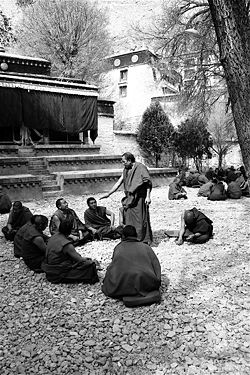
When the mission reached Lhasa, the Dalai Lama had already fled to Urga in Mongolia, Younghusband found the option of returning to India empty-handed untenable, he proceeded to draft a treaty unilaterally, and have it signed in the Potala by the regent, Ganden Tri Rinpoche, and any other local officials he could gather together as an ad hoc government. The treaty made provisions for the frontier between Sikkim and Tibet to be respected, for free trade between British and Tibetan subjects, and for an indemnity to be paid from the Qing court to the British Government for its expenses in dispatching armed troops to Lhasa. The provisions of this 1904 treaty were confirmed in a 1906 treaty Anglo-Chinese Convention signed between Britain and China. The British, for a fee from the Qing court, also agreed "not to annex Tibetan territory or to interfere in the administration of Tibet", while China engaged "not to permit any other foreign state to interfere with the territory or internal administration of Tibet".
The position of British Trade Agent at Gyangzê was occupied from 1904 until 1944. It was not until 1937, with the creation of the position of "Head of British Mission Lhasa", that a British officer had a permanent posting in Lhasa itself.
In 1910, the Qing government sent a military expedition of its own to establish direct Chinese rule and deposed the Dalai Lama in an imperial edict. The Dalai Lama once again fled, this time to British India, in February 1910. The Dalai Lama returned to Tibet from India in July 1912, and by the end of the year the Chinese troops in Tibet had returned, via India, to China Proper.
Proclaiming independence
In early 1913, Agvan Dorzhiev and two other Tibetan representatives signed a treaty between Tibet and Mongolia in Urga, proclaiming mutual recognition and their independence from China. The 13th Dalai Lama himself, however, denied he authorized Agvan Dorzhiev to conclude any treaties on behalf of Tibet. The Tibetan government never ratified this treaty and no Tibetan version of this treaty was published by Tibetan government. A Russian diplomat pointed out to the British ambassador that since Agvan Dorzhiev himself is a Russian subject, his legal ability to sign such a treaty is in question.
Some British authors have even disputed the existence of such a treaty but scholars of Mongolia generally are positive it exists, as were contemporary authors . The Mongolian text of the treaty has, for example, been published by the Mongolian Academy of Sciences in 1982. John Snelling says: "Though sometimes doubted, this Tibet-Mongolia Treaty certainly existed. It was signed on 29 December 1912 (OS) [that is, by the Julian Calendar - thus making it 8 January 1913 by the Gregorian Calendar that we use] by Dorzhiev and two Tibetans on behalf of the Dalai Lama, and by two Mongolians for the Jebtsundamba Khutukhtu." He then quotes the full wording of the treaty (in English) from the British Public Records Office: FO [Foreign Office] 371 1609 7144: Sir George Buchanan to Sir Edward Grey, St. Petersburg, dated 11 February 1913.
Nevertheless, pursuits of complete independence were officially renounced by Tibet and Mongolia respectively in 1914 and 1915. On 3 July, 1914, The Tibetans signed the Simla Convention which reaffirmed Chinese suzerainty and Tibet's status as "part of Chinese territory", and on 25 May, 1915, Mongolia signed a tripartite treaty reaffirming, at least nominally, subordination to China.
The subsequent outbreak of World War I and the division of China into military cliques ruled by warlords caused the Western powers and the infighting factions within China to lose interest in Tibet, and the 13th Dalai Lama ruled undisturbed until his death in 1933. At that time, the government of Tibet controlled all of Ü-Tsang (Dbus-gtsang) and western Kham (Khams), somewhat larger than the Tibet Autonomous Region today. Eastern Kham, separated by the Yangtze River, was under the control of Chinese warlord Liu Wenhui.
In 1935 the 14th Dalai Lama, Tenzin Gyatso was born in Amdo in eastern Tibet and was recognized as the latest reincarnation. He was taken to Lhasa in 1937 where he was later given an official ceremony in 1939. In 1944, during World War II, two Austrian mountaineers, Heinrich Harrer and Peter Aufschnaiter came to Lhasa, where Harrer became a tutor and friend to the young Dalai Lama giving him a sound knowledge of western culture and modern society, until he was forced to leave in 1959.
Since 1951, Tibet has been under China's control. According to a 1951 agreement between the Tibetan government and the PRC, Dalai Lama-ruled Tibetan area was supposed to be a largely autonomous region of China.
'feudal serfdom'
Supporters of the PRC have characterised the socio-economy of Tibet prior to Communism as 'feudal serfdom'. However, supporters of an independent Tibet objected to this assessment. For a discussion of the debate see Allegations of serfdom in Tibet. For a description of the traditional social structure see Social classes of Tibet.
A rebellion against the Chinese occupation was led by noblemen and monasteries and broke out in Amdo and eastern Kham in June 1956. The insurrection, supported by the American CIA, eventually spread to Lhasa. It was crushed by 1959. During this campaign, tens of thousands of Tibetans were killed and the 14th Dalai Lama and other government principals fled to exile in India.
Tibet under PRC
The Central Tibetan Administration states that the number that have died in the Great Leap Forward, of violence, or other indirect causes since 1950 is approximately 1.2 million, which the Chinese Communist Party denies. The Chinese Communist Party's official toll of deaths recorded for the whole of China for the years of the Great Leap Forward is 14 million, but scholars have estimated the number of the famine victims to be between 20 and 43 million. According to Patrick French, the estimate of 1.2 million in Tibet is not reliable because Tibetans were not able to process the data well enough to produce a credible total. There were, however, many casualties, with a figure of 400,000 extrapolated from a calculation Warren W. Smith made from census reports of Tibet which show 200,000 "missing" from Tibet.
The Dalai Lama has stated his willingness to negotiate with China for genuine autonomy, but according to the government in exile and Tibetan independence groups, most Tibetans still call for full Tibetan independence. The Dalai Lama sees the millions of government-imported Han immigrants and preferential socioeconomic policies, as presenting an urgent threat to the Tibetan nation and culture. Tibetan exile groups say that despite recent attempts to restore the appearance of original Tibetan culture to attract tourism, the traditional Tibetan way of life is now irrevocably changed. Tashi Wangdi, the Representative of the Dalai Lama, stated in an interview that China's Western China Development program "is providing facilities for the resettlement of Han Chinese in Tibet."
Projects that the PRC claims to have benefited Tibet as part of the China Western Development economic plan, such as the Qinghai-Tibet Railway, have roused fears of facilitating military mobilisation and Han migration. There is still ethnic imbalance in appointments and promotions to the civil and judicial services in the Tibetan Autonomous Region, with disproportionately few ethnic Tibetans appointed to these posts.
The PRC, on the other hand, claims that its rule over Tibet is an unalloyed improvement, but foreign governments continue to make occasional protests about aspects of PRC rule in Tibet because of frequent reports of human rights violation in Tibet by groups such as Human Rights Watch. The government of the PRC maintains that the Tibetan Government did almost nothing to improve the Tibetans' material and political standard of life during its rule from 1913–59, and that they opposed any reforms proposed by the Chinese government. According to the Chinese government, this is the reason for the tension that grew between some central government officials and the local Tibetan government in 1959.
The government of the PRC also rejects claims that the lives of Tibetans have deteriorated, and states that the lives of Tibetans have been improved immensely compared to self rule before 1950.
The Cultural Revolution and the cultural damage it wrought upon Tibet and, indeed, the entire PRC is generally condemned as a nationwide catastrophe, whose main instigators, in the PRC's view, the so-called Gang of Four, have been brought to justice. The China Western Development plan is viewed by the PRC as a massive, benevolent, and patriotic undertaking by the wealthier eastern coast to help the western parts of China, including Tibet, catch up in prosperity and living standards.
These claims are, however, largely discredited by many Tibetans. In 1989, the Panchen Lama was finally allowed to return to Shigatse, where he addressed a crowd of 30,000 and described what he saw as the suffering of Tibet and the harm being done to his country in the name of socialist reform under the rule of the PRC in terms reminiscent of the petition he had presented to Chinese Premier Zhou Enlai in 1962.. Five days later, he mysteriously died of a massive heart attack at the age of 50.
In 1995 the Dalai Lama named 6 year old Gedhun Choekyi Nyima as the 11th Panchen Lama without Chinese approval, while the PRC named another child, Gyancain Norbu in conflict. Gyancain Norbu was raised in Beijing and has appeared occasionally on state media. The PRC-selected Panchen Lama is rejected by exiled Tibetans and anti-China groups who commonly refer to him as the "Panchen Zuma" (literally "fake Panchen Lama"). Gedhun Choekyi Nyima and his family have gone missing — believed by some to be imprisoned by China — and under a hidden identity for protection and privacy according to the PRC. exile.
In 2001 representatives of Tibet succeeded in gaining accreditation at a United Nations-sponsored meeting of non-governmental organizations. On August 29 Jampal Chosang, the head of the Tibetan coalition, stated that China had introduced "a new form of apartheid" in Tibet because "Tibetan culture, religion, and national identity are considered a threat" to China.
In 2005, Chinese Premier Wen Jiabao's offered to hold talks with the 14th Dalai Lama on the Tibet issue, provided he dropped the demand for independence. The Dalai Lama said in an interview with the South China Morning Post "We are willing to be part of the People's Republic of China, to have it govern and guarantee to preserve our Tibetan culture, spirituality and our environment." A statement that was seen as a renewed diplomatic offensive by the Tibetan government-in-exile. He had already said he would accept Chinese sovereignty over Tibet but insisted on real autonomy over its religious and cultural life. Tibetan government-in-exile, called on the Chinese government to respond. The move was seen to be unpopular with many Tibetans.
In January 2007 the Dalai Lama, in an interview on a private television channel, said "What we demand from the Chinese authority is more autonomy for Tibetans to protect their culture." He added that he had told the Tibetan people not to think in terms of history and to accept Tibet as a part of China.
Talks between representatives of the Dalai Lama and the Chinese government began again in May, 2008 with little result, but more are scheduled to be held in June.
Geography
Tibet is located on the Tibetan Plateau, the world's highest region. The world's highest, Mount Everest, is on Nepal's border with Tibet. The average altitude is about 3,000 m in the south and 4,500 m in the north.
Several major rivers have their source in the Tibetan Plateau (mostly in present-day Qinghai Province). These includeYangtze, Yellow River, Indus River, Mekong, Brahmaputra River, Ganges, Salween and the Yarlung Tsangpo River. The Indus, Brahmaputra rivers originate from a lake (Tib: Tso Mapham) in Western Tibet, near Mount Kailash. The mountain is a holy pilgrimage for both Hindus and Tibetans. The Hindus consider the mountain to be the abode of Lord Shiva. The Tibetan name for Mt Kailash is Khang Rinpoche. Tibet has numerous high-altitude lakes referred to in Tibetan as tso or co. These include Lake Manasarovar, Namtso, Pangong Tso, Yamdrok Lake, Siling Co, Lhamo La-tso, Lumajangdong Co, Lake Puma Yumco, Lake Paiku, Lake Rakshastal, Dagze Co and Dong Co
The atmosphere is severely dry nine months of the year, and average annual snowfall is only 18 inches, due to the rain shadow effect whereby mountain ranges prevent moisture from the ocean from reaching the plateaus. Western passes receive small amounts of fresh snow each year but remain traversable all year round. Low temperatures are prevalent throughout these western regions, where bleak desolation is unrelieved by any vegetation beyond the size of low bushes, and where wind sweeps unchecked across vast expanses of arid plain. The Indian monsoon exerts some influence on eastern Tibet. Northern Tibet is subject to high temperatures in the summer and intense cold in the winter.
Historic Tibet consists of several regions. These include Amdo (A mdo) in the northeast, incorporated by China into the provinces of Qinghai, Gansu and Sichuan., Kham(Khams) in the east, divided between Sichuan, northern Yunnan and Qinghai., Western Kham, part of the Tibetan Autonomous Region and Ü-Tsang (dBus gTsang) (Ü in the center, Tsang in the centre-west, and Ngari (mNga' ris) in the far west), part of the Tibetan Autonomous Region.
Tibetan cultural influences extend to the neighboring states of Bhutan, Nepal, adjacent regions of India such as Sikkim and Ladakh, and adjacent provinces of China where Tibetan Buddhism is the predominant religion.
On the border with India, the region popularly known among Chinese as South Tibet is claimed by China and administered by India as the state of Arunachal Pradesh.
Cities, towns and villages

There are over 800 settlements in Tibet, Lhasa is Tibet's traditional capital and the capital of Tibet Autonomous Region. Lhasa contains the world heritage site the Potala Palace and Norbulingka, the residences of the Dalai Lama. Lhasa contains a number of significant temples and monasteries which are deeply engrained in its history including Jokhang and Ramoche Temple.
Shigatse is the country's second largest city, west of Lhasa. Gyantse, Chamdo are also amongst the largest.
Other cities in Historic Tibet include, Nagchu, Nyingchi, Nedong, Barkam, Sakya, Gartse, Pelbar, Lhatse, and Tingri; in Sichuan, Kangding (Dartsedo); in Qinghai, Jyekundo or Yushu, Machen, and Golmud. There is also a large Tibetan settlement in South India near Kushalanagara. India created this settlement for Tibetan refugees which had fled to India.
Economy
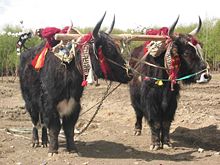
According to Chinese sources, Tibet's GDP in 2001 was 13.9 billion yuan (USD1.8billion). The Central government exempts Tibet from all taxation and provides 90% of Tibet's government expenditures. The Tibetan economy is dominated by subsistence agriculture. Due to limited arable land, livestock raising is the primary occupation mainly on the Tibetan Plateau, among them are sheep, cattle, goats, camels, yaks and horses. However, the main crops grown are barley, wheat, buckwheat, rye, potatoes and assorted fruits and vegetables.
In recent years, due to the increased interest in Tibetan Buddhism, tourism has become an increasingly important sector, and is actively promoted by the authorities. The Tibetan economy is heavily subsidized by the Central government and government cadres receive the second-highest salaries in China.
Tourism brings in the most income from the sale of handicrafts. These include Tibetan hats, jewelry (silver and gold), wooden items, clothing, quilts, fabrics, Tibetan rugs and carpets. The Qinghai-Tibet Railway which links the region to Qinghai in China proper was opened in 2006. The Chinese government claims that the line will promote the development of impoverished Tibet. But opponents argue the railway will harm Tibet. For instance, Tibetan opponents contend that it would only draw more Han Chinese residents, the country's dominant ethnic group, who have been migrating steadily to Tibet over the last decade, bringing with them their popular culture. Opponents believe that the large influx of Han Chinese will ultimately extinguish the local culture.
Other opponents argue that the railway will damage Tibet's fragile ecology and that most of its economic benefits will go to migrant Han Chinese. As activists call for a boycott of the railway, the Dalai Lama has urged Tibetans to "wait and see" what benefits the new line might bring to them. According to the Government-in-exile's spokesmen, the Dalai Lama welcomes the building of the railway, "conditioned on the fact that the railroad will bring benefit to the majority of Tibetans."
In January 2007, the Chinese government issued a report outlining the discovery of a large mineral deposit under the Tibetan Plateau. The deposit has an estimated value of $128 billion and may double Chinese reserves of zinc, copper, and lead. The Chinese government sees this as a way to alleviate the nation's dependence on foreign mineral imports for its growing economy. However, critics worry that mining these vast resources will harm Tibet's fragile ecosystem as well take valuable resources away from the Tibetan people.
Demographics
Historically, the population of Tibet consisted of primarily ethnic Tibetans. Other ethnic groups in Tibet include Menba (Monpa), Lhoba, Mongols and Hui Chinese. According to tradition the original ancestors of the Tibetan people, as represented by the six red bands in the Tibetan flag, are: the Se, Mu, Dong, Tong, Dru and Ra.
The issue of the proportion of the Han Chinese population in Tibet is a politically sensitive one. The Central Tibetan Administration, an exile group, says that the PRC has actively swamped Tibet with Han Chinese migrants in order to alter Tibet's demographic makeup.
View of the Tibetan exile community
Between the 1960s and 1980s, many prisoners (over 1 million, according to Harry Wu) were sent to laogai camps in Amdo ( Qinghai), where they were then employed locally after release. Since the 1980s, increasing economic liberalization and internal mobility has also resulted in the influx of many Han Chinese into Tibet for work or settlement, though the actual number of this floating population remains disputed.
The Government of Tibet in Exile claims that, despite official statistics to the contrary, in reality non-ethnic Tibetans (including Han Chinese and Hui Muslims) outnumber ethnic Tibetans. It claims that this is as a result of an active policy of demographically swamping the Tibetan people and further diminishing any chances of Tibetan political independence. The Dalai Lama has recently been reported as saying that the Tibetans had been reduced to a minority "in his homeland", by reference to population figures of Lhasa, and accusing China of "demographic aggression".
The Government of Tibet in Exile questions all statistics given by the PRC government, since they do not include members of the People's Liberation Army garrisoned in Tibet, or the large floating population of unregistered migrants. The Qinghai-Tibet Railway ( Xining to Lhasa) is also a major concern, as it is believed to further facilitate the influx of migrants.
The Government of Tibet in Exile quotes an issue of People's Daily published in 1959 to claim that the Tibetan population has dropped significantly since 1959. According to the article, figures from the National Bureau of Statistics of the PRC show that the autonomous region of Tibet was populated by 1,273,969 persons. In the Tibetan sectors of Kham, 3,381,064 Tibetans were counted. In Qinghai and other Tibetan sectors that are incorporated in Gansu, 1,675,534 Tibetans were counted. According to the total of these three numbers, the Tibetan population attained 6,330,567 in 1959.
In 2000, the number of Tibetans as a whole of these regions was about 5,400,000 according to National Bureau of Statistics.
The Tibetan exile Government's analysis of these statistics originating from National Bureau of Statistics shows that in between 1959 and 2000, the Tibetan population decreased by about one million, a 15% decline. During the same period, the Chinese population doubled, and the world-wide population increased by 3-fold. This analysis gives an additional argument concerning the estimation of the number of Tibetan deaths during the period between 1959 and 1979. It also suggests the existence of a demographic deficit of the Tibetan population and the precise time course and causes must be specified.
The accuracy of this 1959 Tibetan population estimate quoted by the Government of Tibet in Exile is in conflict with the findings of the 1954 Chinese census report. The census states that the total population of the autonomous region of Tibet was 1,273,969; the total population of Kham was 3,381,064; and the total population of Qinghai was 1,675,534. These numbers were taken by the Government of Tibet in Exile as the population of Tibetans in each province.
View of the People's Republic of China
The PRC government does not view itself as an occupying power and has vehemently denied allegations of demographic swamping. The PRC also does not recognize Greater Tibet as claimed by the government of Tibet in Exile, saying that the idea was engineered by foreign imperialists as a plot to divide China amongst themselves, (Mongolia being a striking precedent, gaining independence with Soviet backing and subsequently aligning itself with the Soviet Union) and that those areas outside the TAR were not controlled by the Tibetan government before 1959 in the first place, having been administered instead by other surrounding provinces for centuries.
The PRC gives the number of Tibetans in Tibet Autonomous Region as 2.4 million, as opposed to 190,000 non-Tibetans, and the number of Tibetans in all Tibetan autonomous entities combined (slightly smaller than the Greater Tibet claimed by exiled Tibetans) as 5.0 million, as opposed to 2.3 million non-Tibetans. In the TAR itself, much of the Han population is to be found in Lhasa. Population control policies like the one-child policy only apply to Han Chinese, not to minorities such as Tibetans .
Jampa Phuntsok, chairman of the TAR, has also said that the central government has no policy of migration into Tibet due to its harsh high-altitude conditions, that the 6% Han in the TAR is a very fluid group mainly doing business or working, and that there is no immigration problem.
With regards to the historical population of ethnic Tibetans, the Chinese government claims that according to the First National Census conducted in 1954, there were 2,770,000 ethnic Tibetans in China, including 1,270,000 in the TAR; whereas in the Fourth National Census conducted in 1990, there were 4,590,000 ethnic Tibetans in China, including 2,090,000 in the TAR. These figures are used to advance the claim that the Tibetan population has doubled since 1951.
This table includes all Tibetan autonomous entities in the PRC, plus Xining PLC and Haidong P. The latter two are included to complete the figures for Qinghai province, and also because they are claimed as parts of Greater Tibet by the Government of Tibet in exile.
P = Prefecture; AP = Autonomous prefecture; PLC = Prefecture-level city; AC = Autonomous county.
Excludes members of the People's Liberation Army in active service.
| Major ethnic groups in Greater Tibet by region, 2000 census. | |||||||
|---|---|---|---|---|---|---|---|
| Total | Tibetans | Han Chinese | others | ||||
| Tibet Autonomous Region: | 2,616,329 | 2,427,168 | 92.8% | 158,570 | 6.1% | 30,591 | 1.2% |
| - Lhasa PLC | 474,499 | 387,124 | 81.6% | 80,584 | 17.0% | 6,791 | 1.4% |
| - Qamdo Prefecture | 586,152 | 563,831 | 96.2% | 19,673 | 3.4% | 2,648 | 0.5% |
| - Shannan Prefecture | 318,106 | 305,709 | 96.1% | 10,968 | 3.4% | 1,429 | 0.4% |
| - Xigazê Prefecture | 634,962 | 618,270 | 97.4% | 12,500 | 2.0% | 4,192 | 0.7% |
| - Nagqu Prefecture | 366,710 | 357,673 | 97.5% | 7,510 | 2.0% | 1,527 | 0.4% |
| - Ngari Prefecture | 77,253 | 73,111 | 94.6% | 3,543 | 4.6% | 599 | 0.8% |
| - Nyingchi Prefecture | 158,647 | 121,450 | 76.6% | 23,792 | 15.0% | 13,405 | 8.4% |
| Qinghai Province: | 4,822,963 | 1,086,592 | 22.5% | 2,606,050 | 54.0% | 1,130,321 | 23.4% |
| - Xining PLC | 1,849,713 | 96,091 | 5.2% | 1,375,013 | 74.3% | 378,609 | 20.5% |
| - Haidong Prefecture | 1,391,565 | 128,025 | 9.2% | 783,893 | 56.3% | 479,647 | 34.5% |
| - Haibei AP | 258,922 | 62,520 | 24.1% | 94,841 | 36.6% | 101,561 | 39.2% |
| - Huangnan AP | 214,642 | 142,360 | 66.3% | 16,194 | 7.5% | 56,088 | 26.1% |
| - Hainan AP | 375,426 | 235,663 | 62.8% | 105,337 | 28.1% | 34,426 | 9.2% |
| - Golog AP | 137,940 | 126,395 | 91.6% | 9,096 | 6.6% | 2,449 | 1.8% |
| - Gyêgu AP | 262,661 | 255,167 | 97.1% | 5,970 | 2.3% | 1,524 | 0.6% |
| - Haixi AP | 332,094 | 40,371 | 12.2% | 215,706 | 65.0% | 76,017 | 22.9% |
| Tibetan areas in Sichuan province | |||||||
| - Ngawa AP | 847,468 | 455,238 | 53.7% | 209,270 | 24.7% | 182,960 | 21.6% |
| - Garzê AP | 897,239 | 703,168 | 78.4% | 163,648 | 18.2% | 30,423 | 3.4% |
| - Muli AC | 124,462 | 60,679 | 48.8% | 27,199 | 21.9% | 36,584 | 29.4% |
| Tibetan areas in Yunnan province | |||||||
| - Dêqên AP | 353,518 | 117,099 | 33.1% | 57,928 | 16.4% | 178,491 | 50.5% |
| Tibetan areas in Gansu province | |||||||
| - Gannan AP | 640,106 | 329,278 | 51.4% | 267,260 | 41.8% | 43,568 | 6.8% |
| - Tianzhu AC | 221,347 | 66,125 | 29.9% | 139,190 | 62.9% | 16,032 | 7.2% |
| Total for Greater Tibet: | |||||||
| With Xining and Haidong | 10,523,432 | 5,245,347 | 49.8% | 3,629,115 | 34.5% | 1,648,970 | 15.7% |
| Without Xining and Haidong | 7,282,154 | 5,021,231 | 69.0% | 1,470,209 | 20.2% | 790,714 | 10.9% |
Human rights
According to the non-government Save Tibet website, the Tibetan people are denied most rights guaranteed in the Universal Declaration of Human Rights, including the rights to self-determination, freedom of speech, assembly, movement, expression, and travel. Elliot Sperling, an Associate Professor of Tibetan Studies at Indiana University, in a statement to the Human Rights Watch, also detailed human rights violation in Tibet. The Tibet Justice.org claims that according to UN Development Programme data, Tibet is ranked the lowest among China’s 31 provinces, and is ranked 153 out of the 160 countries on the Human Development Index.
Amnesty International has stated that political prisoners are often beaten and tortured, and sometimes summarily executed. Since the 1988 ratification of the UN Convention Against Torture by China, 69 Tibetans are recorded as having died as a result of torture in Chinese prisons. Human rights groups have confirmed by name over 700 Tibetan political prisoners in Tibet, many of them detained without charge or trial.
Tibetologist Thomas Laird claims that there is no evidence to support China's claim that Tibet is autonomous, as all local legislation is subject to approval of the central government in Beijing.
The Tibetan exile government claims that China does not allow independent human rights organisations into Tibet, and foreign delegations invited to Tibet are denied independent access to meet with Tibetans. The Tibetan Centre for Human Rights and Democracy claims that more than 11,000 monks and nuns have been expelled from Tibet since 1996 for opposing "patriotic re-education" sessions conducted at monasteries and nunneries under the "Strike Hard" campaign.
Thomas Laird also claims that China continues to encourage the transfer of Chinese settlers into Tibet. This threatens the survival of the Tibetan religious, cultural and national identity. The Free Tibet website claims that unemployment in schools, discussion of Tibetan cultural, religious and social issues is discouraged, and Chinese culture is promoted.
The Tibetan Centre for Human Rights and Democracy claims that unemployment among Tibetans is high. An unequal taxation system further exacerbates the conditions of poverty for Tibetans in rural areas. Many basic rights, such as the right to housing, education and health, remain unfulfilled.
Culture
Religion
Tibetan Buddhism
Religion and spirituality is extremely important to the Tibetans and has a strong influence over all aspects of lives; ingrained deeply into their cultural heritage. Bön is the ancient traditional religion of Tibet, but following the introduction of Tantric Buddhism into Tibet by Padmasambhava this became eclipsed by Tibetan Buddhism, a distinctive form of Vajrayana. Tibetan Buddhism is practiced not only in Tibet but also in Mongolia, parts of northern India, the Buryat Republic, the Tuva Republic, and in the Republic of Kalmykia.
Tibetan Buddhism has four main traditions (the suffix pa is comparable to "er" in English):
- Gelug(pa), Way of Virtue, also known casually as Yellow Hat, whose spiritual head is the Ganden Tripa and whose temporal, the Dalai Lama. Successive Dalai Lamas ruled Tibet from the mid-17th to mid-20th centuries. This order was founded in the 14th to 15th century by Je Tsongkhapa, based on the foundations of the Kadampa tradition. Tsongkhapa was renowned for both his scholasticism and his virtue. The Dalai Lama belongs to the Gelugpa school, and is regarded as the embodiment of the Bodhisattva of Compassion.
- Kagyu(pa), Oral Lineage. This contains one major subsect and one minor subsect. The first, the Dagpo Kagyu, encompasses those Kagyu schools that trace back to Gampopa. In turn, the Dagpo Kagyu consists of four major sub-sects: the Karma Kagyu, headed by a Karmapa, the Tsalpa Kagyu, the Barom Kagyu, and Pagtru Kagyu. There are further eight minor sub-sects, all of which trace their root to Pagtru Kagyu. Among the eight sub-sects the most notable of are the Drikung Kagyu and the Drukpa Kagyu. The once-obscure Shangpa Kagyu, which was famously represented by the 20th century teacher Kalu Rinpoche, traces its history back to the Indian master Niguma, sister of Kagyu lineage holder Naropa. This is an oral tradition which is very much concerned with the experiential dimension of meditation. Its most famous exponent was Milarepa, an eleventh century mystic.
- Nyingma(pa), The Ancient Ones. This is the oldest, the original order founded by Padmasambhava.
- Sakya(pa), Grey Earth, headed by the Sakya Trizin, founded by Khon Konchog Gyalpo, a disciple of the great translator Drokmi Lotsawa. Sakya Pandita 1182–1251CE was the great grandson of Khon Konchog Gyalpo. This school very much represents the scholarly tradition.
Islam
In Tibetan cities, there are also small communities of Muslims, known as Kachee (Kache), who trace their origin to immigrants from three main regions: Kashmir (Kachee Yul in ancient Tibetan), Ladakh and the Central Asian Turkic countries. Islamic influence in Tibet also came from Persia. After 1959 a group of Tibetan Muslims made a case for Indian nationality based on their historic roots to Kashmir and the Indian government declared all Tibetan Muslims Indian citizens later on that year. There is also a well established Chinese Muslim community (gya kachee), which traces its ancestry back to the Hui ethnic group of China. It is said that Muslim migrants from Kashmir and Ladakh first entered Tibet around the 12th century. Marriages and social interaction gradually led to an increase in the population until a sizable community grew up around Lhasa.
Buddhist monasteries in Tibet
Tibetan art
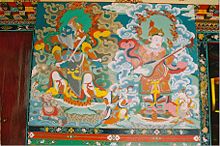
Tibetan representations of art are intrinsically bound with Tibetan Buddhism and commonly depict deities or variations of Buddha in various forms from bronze Buddhist statues and shrines, to highly colorful thangka paintings and mandalas.
Architecture
Tibetan architecture contains Oriental and Indian influences, and reflects a deeply Buddhist approach. The Buddhist wheel, along with two dragons, can be seen on nearly every Gompa in Tibet. The design of the Tibetan Chörtens can vary, from roundish walls in Kham to squarish, four-sided walls in Ladakh.
The most distinctive feature of Tibetan architecture is that many of the houses and monasteries are built on elevated, sunny sites facing the south, and are often made out of a mixture of rocks, wood, cement and earth. Little fuel is available for heat or lighting, so flat roofs are built to conserve heat, and multiple windows are constructed to let in sunlight. Walls are usually sloped inwards at 10 degrees as a precaution against frequent earthquakes in the mountainous area.
Standing at 117 meters in height and 360 meters in width, the Potala Palace is considered as the most important example of Tibetan architecture. Formerly the residence of the Dalai Lama, it contains over one thousand rooms within thirteen stories, and houses portraits of the past Dalai Lamas and statues of the Buddha. It is divided between the outer White Palace, which serves as the administrative quarters, and the inner Red Quarters, which houses the assembly hall of the Lamas, chapels, 10,000 shrines, and a vast library of Buddhist scriptures.
Music
The music of Tibet reflects the cultural heritage of the trans-Himalayan region, centered in Tibet but also known wherever ethnic Tibetan groups are found in India, Bhutan, Nepal and further abroad. First and foremost Tibetan music is religious music, reflecting the profound influence of Tibetan Buddhism on the culture.
Tibetan music often involves chanting in Tibetan or Sanskrit, as an integral part of the religion. These chants are complex, often recitations of sacred texts or in celebration of various festivals. Yang chanting, performed without metrical timing, is accompanied by resonant drums and low, sustained syllables. Other styles include those unique to the various schools of Tibetan Buddhism, such as the classical music of the popular Gelugpa school, and the romantic music of the Nyingmapa, Sakyapa and Kagyupa schools.
Nangma dance music is especially popular in the karaoke bars of the urban centre of Tibet, Lhasa. Another form of popular music is the classical gar style, which is performed at rituals and ceremonies. Lu are a type of songs that feature glottal vibrations and high pitches. There are also epic bards who sing of Tibet's national hero Gesar.
Festivals
Tibet has various festivals which commonly are performed to worship the Buddha throughout the year. Losar is the Tibetan New Year Festival. Preparations for the festive event are manifested by special offerings to family shrine deities, painted doors with religious symbols, and other painstaking jobs done to prepare for the event. Tibetans eat Guthuk (barley crumb food with filling) on New Year's Eve with their families. The Monlam Prayer Festival follows it in the first month of the Tibetan calendar, falling on the fourth up to the eleventh day of the first Tibetan month. which involves many Tibetans dancing and participating in sports events and sharing picnics. The event was established in 1049 by Tsong Khapa, the founder of the Dalai Lama and the Panchen Lama's order.
Other
The Potala Palace, former residence of the Dalai Lamas, is a World Heritage Site, as is Norbulingka, former summer residence of the Dalai Lama.
Since 2002, Tibetans in exile have allowed a Miss Tibet beauty contest in spite of concerns that this event is considered a Western influence. The beauty contest is condemned by the Tibetan government in exile.
Cuisine
The most important crop in Tibet is barley, and dough made from barley flour called tsampa, is the staple food of Tibet. This is either rolled into noodles or made into steamed dumplings called momos. Meat dishes are likely to be yak, goat, or mutton, often dried, or cooked into a spicy stew with potatoes. Mustard seed is cultivated in Tibet, and therefore features heavily in its cuisine. Yak yoghurt, butter and cheese are frequently eaten, and well-prepared yoghurt is considered something of a prestige item. Butter tea is very popular to drink.
Tibet in popular culture
In recent years there have been a number of films produced about Tibet, most notably Hollywood films such as Seven Years in Tibet, starring Brad Pitt, and Kundun, a biography of the 14th Dalai Lama, directed by Martin Scorsese. Both of these films were banned by the Chinese government because of Tibetan nationalist overtones. Other films include Samsara, The Cup and the 1999 Himalaya, a French-American produced film with a Tibetan cast set in Nepal and Tibet. In 2005, exile Tibetan filmmaker Tenzing Sonam and his partner Ritu Sarin made Dreaming Lhasa, the first internationally recognized feature film to come out of the diaspora to explore the contemporary reality of Tibet.
Kekexili: Mountain Patrol, is a film made by National Geographic about a Chinese reporter that goes to Tibet to report on the issue involving the endangerment of Tibetan Antelope. It won numerous awards at home and abroad.
In 1995 a British electronic music act Banco de Gaia released the album Last Train to Lhasa, dedicated to the music of Tibet, with many samples of Tibetan chanting.
